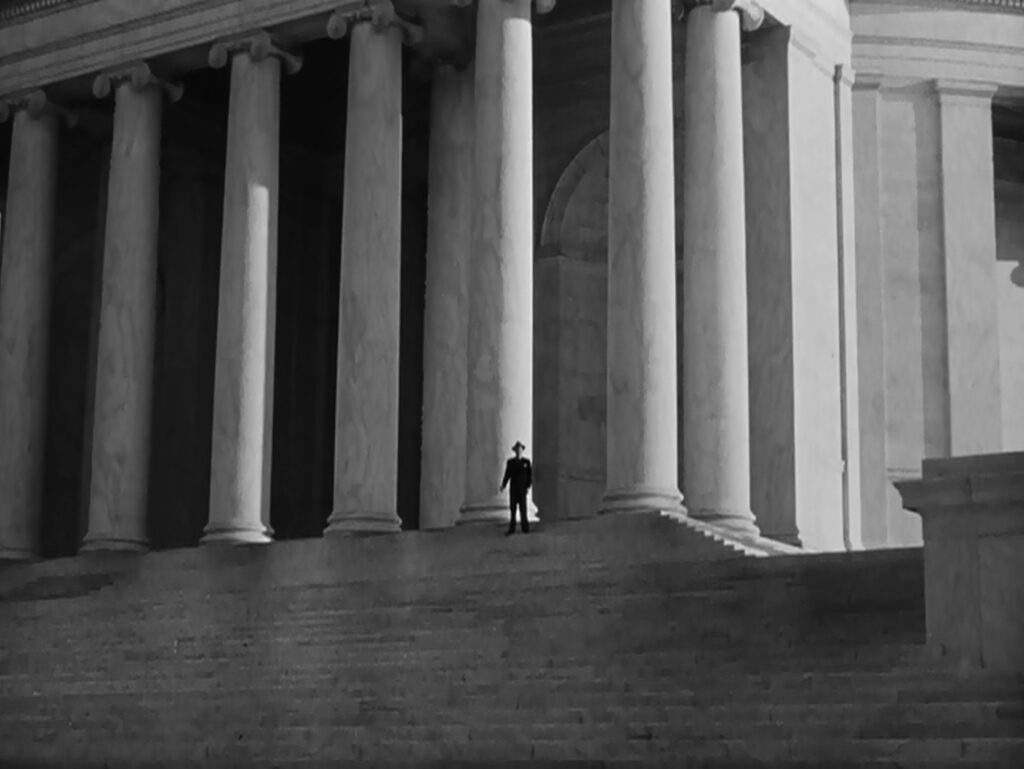
Strangers on a Train
1951, directed by Alfred Hitchcock
In one of Strangers on a Train‘s most suspenseful scenes, Guy Haines sneaks into Bruno Antony’s mansion at night, having agreed on the phone to carry out his end of the double murder scheme by killing Bruno’s hated father. Of course he has no intention of murdering anyone; he’s come to warn the old man of Bruno’s plans. When he reaches the darkened bedroom and begins to address the father, the light goes on, and Bruno is there instead. This twist is more than just a shock effect or a plot element. It’s sexually symbolic that Bruno usurps his father’s place in bed, insinuating that Bruno wishes to take over his father’s relationship to his mother. Having already seen Bruno with his mother, we know all too well that he’s a deranged “mama’s boy” motivated by an acute Oedipus complex.
Hitchcock had already given supporting roles to Oedipus and Elektra complexes in earlier films, and at the peak of his career, from Rear Window to Psycho, the consequences of lingering childhood incest would become his dominant subject. Strangers on a Train is in the middle of this spectrum; the topic is coming into the foreground, but it’s not yet fully elaborated. Nevertheless the major pieces of the dynamic are there. Bruno’s complex is not merely a perversion or some quirk in his maternal relationship; it causes him to hate his father and turns him into a killer of women. The similarity between his psychological profile and Norman Bates in Psycho is highlighted when Bruno says his mother “hasn’t been well for a long time. She’s a little… how shall I say… confused”, which is eerily similar to Norman Bates’ line, “Mother… what is the phrase… she isn’t herself today.”
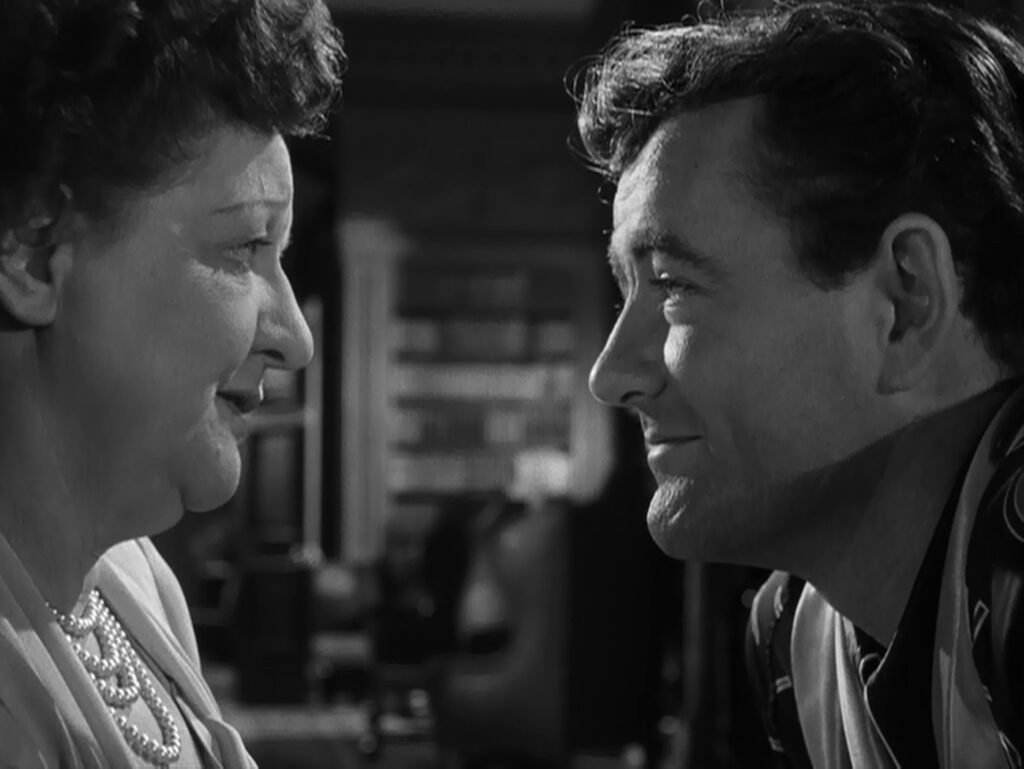
Hitchcock’s films do not merely repeat the insights about childhood incest found in Freud or in Greek drama. Freud took a psychiatrist’s view of unresolved juvenile sexuality, treating it dispassionately as a malady to be cured, whereas Hitchcock looked at it with outright reprehension. From Strangers on a Train onward his films put the oedipal male in a real-world context, regarding him as a primary threat to the social fabric. By setting Strangers on a Train in the capital of the United States, Hitchcock warns Americans to guard their nation against the homegrown danger of psychological corruption. The capitol dome in the opening shot should remind viewers of the national dignity they must preserve against all sorts of Brunos, and the movie periodically reinforces this by putting the presidential monuments (Jefferson, Washington, and Lincoln) in the background and a portrait of George Washington in Senator Morton’s parlor. Morton himself, played by Leo G. Carroll, embodies the nobility of his office coexistent with an obtuseness that makes him vulnerable to Bruno’s approaches.
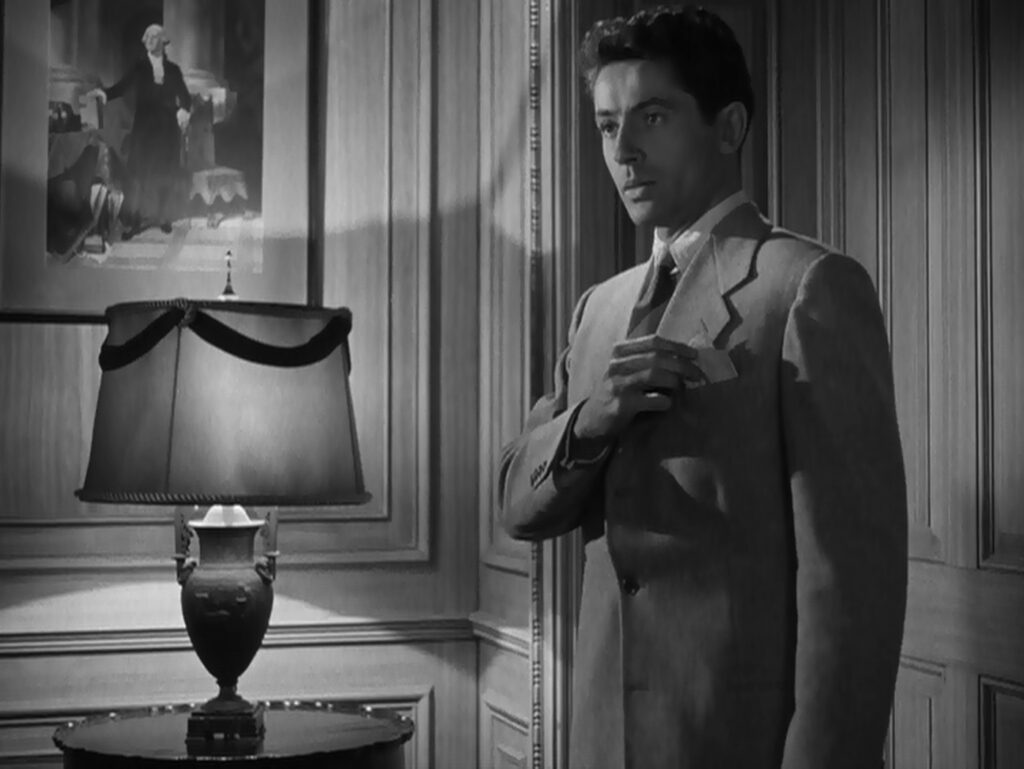
Just as Bruno foreshadows the incestuous man-boys of Hitchcock’s later films, there’s a side plot that looks back to the young women of his earlier films who grew out of their incestuous phases. Senator Morton’s younger daughter Barbara, played by Hitchcock’s own daughter Patricia, traces an arc of increasing maturity in three stages. She starts out as an aloof observer of the events around her, making frank but witty observations that her father finds in poor taste; then she’s passively drawn into the action by Bruno’s obsessive interest in her (owing to her resemblance to Guy’s wife); and finally she becomes an active participant, distracting Hennessey so Guy can escape to Metcalf and prevent Bruno from planting the lighter at the crime scene. In the process Barbara goes from vaguely incestuous longings – she seems to have a crush on her sister’s boyfriend – to a mature sexuality. She deliberately spills powder on Hennessey’s crotch and brushes it off herself, signaling her readiness for an adult sexual connection, just as young Charlie is drawn to the detective at the end of Shadow of a Doubt.
Strangers on a Train is in many ways the quintessential Hitchcock movie, a showcase for the director’s hallmarks: an innocent man suspected of murder, railroad journeys, iconic landmarks as backdrops, Freudian psychology, dark humor, and expertly directed suspense. The movie marks a transition in the middle of Hitchcock’s career, revitalizing his public appeal after a string of four flops. It falls roughly in the middle of his transition to color, with two color films behind it and three black and white films ahead of it. Moreover it’s the last time Hitchcock relied so heavily on an organizing motif. Like the Americana in Saboteur, the ring in Shadow of a Doubt, or the doors in Spellbound, a pattern of “criss-crossing” governs many of the directorial choices in Strangers on a Train. From here on he drops the recurring motif like a pair of training wheels, although it reappears in a weaker form in Torn Curtain and Topaz.
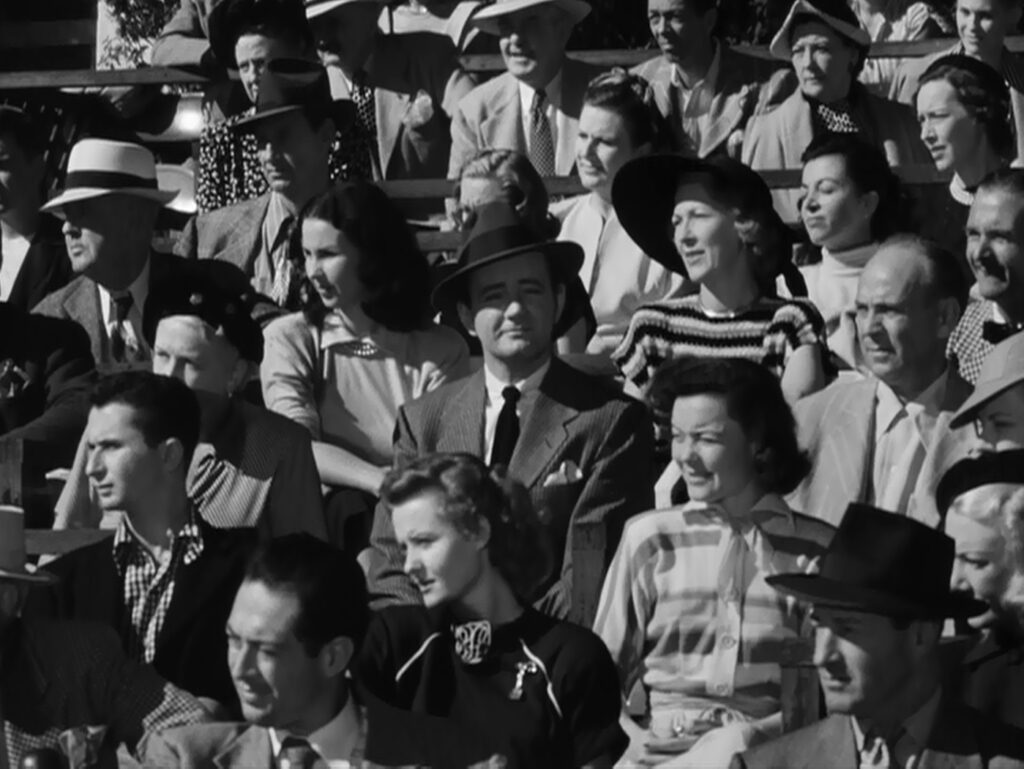
The idea of the “criss-cross” arises in Bruno’s idea to swap murders, each man killing someone the other wants gone: “Your wife, my father. Criss-cross.” When Bruno repeats “criss-cross” to himself at the end of the scene, his words immediately materialize in the image of a railroad crossing sign. The phrase finds a physical symbol in the pair of tennis rackets forming an “X” on the all-important cigarette lighter, and it takes abstract form in all the cross-cutting and back-and-forth motion that dominates the film. The opening alternates between two pairs of legs, Bruno in white shoes and Guy in black, leading to their shoes criss-crossing at their first encounter. Three times a character speaks of being “double-crossed”: Guy to Miriam, then Bruno to Guy about Miriam, and finally Bruno to Guy when the villain feels betrayed. Tennis itself is a game of criss-crossing, with two players lobbing a ball over a net, often diagonally to opposite corners. The famous image of spectators turning their heads right and left while Bruno remains motionless, his gaze fixed on Guy, is another form of crossing, as is Bruno’s confusion between Miriam and Barbara.
Some instances of alternation are hidden like Easter eggs. At the amusement park a boy in a cowboy hat yells “Bang, bang!” and Bruno responds with another bang, popping the kid’s balloon with his cigarette. At the end of the same scene, after killing a woman in clear glasses, Bruno assists a blind man wearing dark glasses. The second and third scenes, where Guy meets his ex-wife and Bruno meets his mother, mirror each other almost invisibly: one scene revolves around music (the record store) while the other climaxes on a painting; one starts with Miriam telling Guy he looks tanned, the other with Mrs. Antony telling Bruno he looks pale; one ends in disagreement while the other shows a weird kind of agreement that’s even worse.
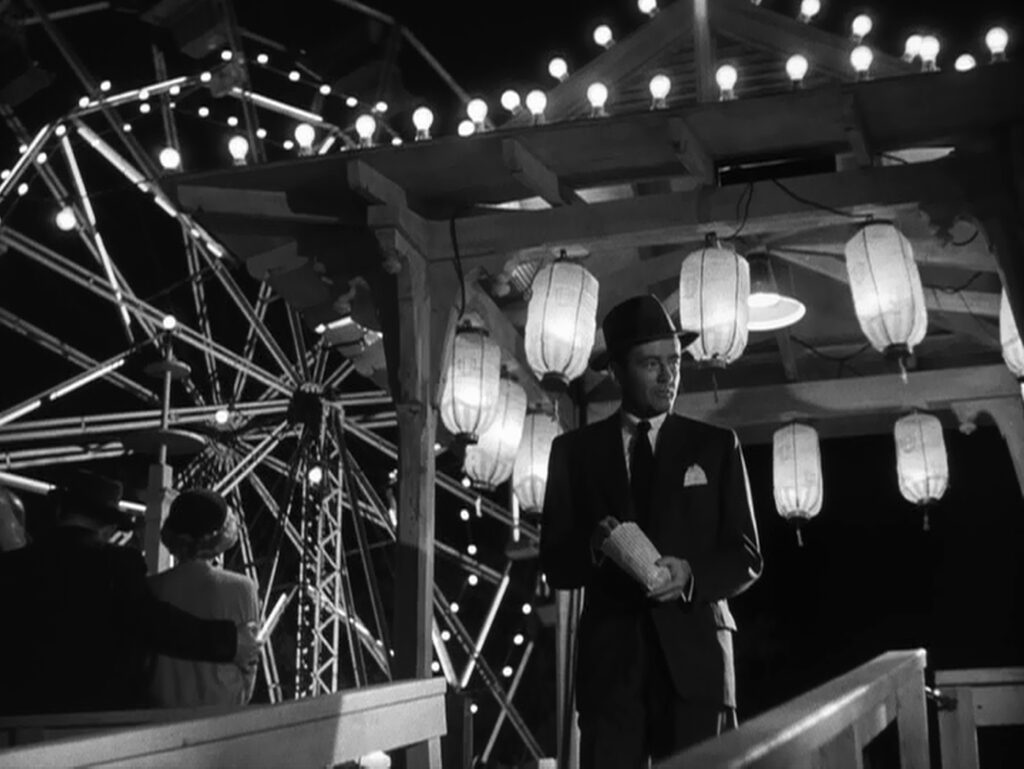
In addition to all these forms of alternation there’s plenty of standard cross-cutting, usually portending a potential conflict. Guy and Ann are mostly framed together when they’re in harmony, but when Ann begins to suspect his involvement in Miriam’s murder, the scene cuts back and forth between them. At the senator’s party cross-cutting builds tension when Bruno begins to strangle Mrs. Cunningham. When Guy enters Bruno’s house, the scene cuts ten times between him and the guard dog. The cross-cutting forebodes violence, but when Guy finally meets the dog in the same frame, letting him proceed calmly, it ought to be even more alarming. Presumably the dog has been trained to protect its master, and the fact that it doesn’t attack Guy means Bruno’s father is not at home.
The most memorable cross-cutting is between Guy’s tennis match and Bruno’s walk to the amusement park to plant the lighter. The two overlapping scenes culminate in a simultaneous victory as Guy wins his match and Bruno retrieves the lighter from the storm drain. These paired triumphs link the two characters, as if Bruno is a kind of doppelgänger for Guy, carrying out the murder that Guy would never admit to wishing for. If the movie hints at a doppelgänger relationship however, it ultimately serves to highlight the chief difference between them – between a normal man with dark thoughts and an actual criminal who acts on his worst impulses. This difference of course goes back to childhood sexuality. Guy is able to restrain his criminal urges, function in society, and hold a healthy relationship because unlike Bruno he has outgrown his infantile incest.
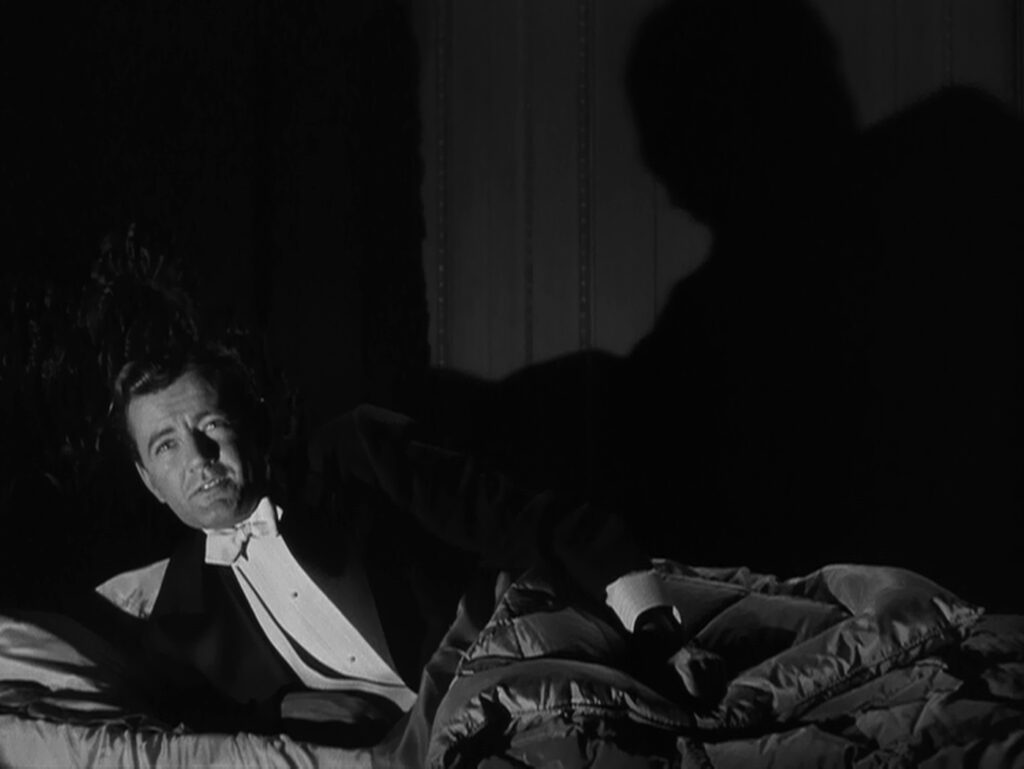
All this criss-crossing and back-and-forth points to Strangers on a Train‘s key moment, reiterating the perverse switch in Bruno’s parents’ bed. Guy finds Bruno lying there with a shadow looming behind him, reminding us of the man whose place he has taken, both literally and figuratively. Bruno’s desire to switch places with his father may seem like an aberration, and he’s certainly portrayed as a madman, but Hitchcock’s subsequent films will stress how common people like Bruno are, and how their hatred and possessiveness account for so many social ills. To echo this switch so insistently through criss-crossing and cross-cutting may not communicate the idea too plainly, but Hitchcock knew that audiences had little appetite for stories of juvenile sexuality, and he needed to be subtle if he was going to make a big issue of it. Nevertheless Bruno’s scene with his mother is fairly open about the phenomenon, even more than Claude Rains’ character in Notorious. Only once in his career, driven to the point of exasperation, would Hitchcock be more direct in portraying a man stuck in his childhood incest – although his most powerful expression of the topic would come in a movie where it’s hidden.
CONNECTIONS:
The Cabinet of Dr. Caligari – Shadow on wall at or right before murder; fairground with wild carousel
The Lady Vanishes – Young woman’s development from Elektral sexuality to maturity
Shadow of a Doubt – Strangler who’s cozy with older women; girl with crush on adult uncle or sister’s boyfriend, transfered later onto a policeman
Born Yesterday – Symbolic use of the U.S. Capitol, Jefferson Memorial, and National Gallery of Art
Rear Window – Study of an oedipal male in preparation for Vertigo
Vertigo – Oedipal male as a threat to society
North by Northwest – Arc of maturity in three stages
Psycho – Oedipal villain; line about the villain’s mother being unwell
Le boucher – Cigarette lighter as the clue to a murderer; killer prefers his mother to his father
Frenzy – Insinuation of an oedipal relationship when the villain is in or near a bed
Hannibal – Use of Washington DC, the Capitol, and Union Station to indicate social corruption near the center of power in the U.S.A.